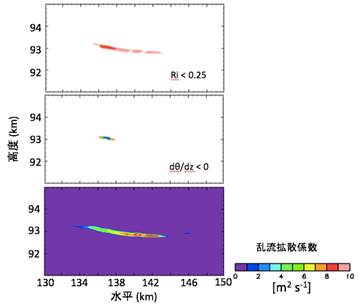Numerical study of the convection structure in planetary atmospheres
JAXA Supercomputer System Annual Report April 2016-March 2017
Report Number: R16E0048
- Responsible Representative: Ko-ichiro Sugiyama(Matsue College)
- Contact Information: Ko-ichiro Sugiyama(sugiyama@gfd-dennou.org)
- Members: Hiroki Ando, Ko-ichiro Sugiyama
- Subject Category: Space(Moon Planet,Space philosophy)
Abstract
Gravity waves influence the atmospheric motion due to the heat and momentum transports associated with their propagation and breaking. In order to investigate propagation and breaking of the gravity waves main source of which is convection, we perform numerical experiment using our cloud resolving model. Our results indicate that their breaking is caused by shear instability and convective instability.
Goal
Our purpose is tosupport the observation performed by AKATSUKI (Venus Climate Orbiter) by developing a numerical model which is suitable for studies associated with convection and gravity waves (cloud resolving model).
Objective
By using a cloud resolving model, we perform a numerical experiment to reproduce the convective motion and upward propagating gravity waves generated by the convection. It is a unique attempt to reproduce them at the same time in one numerical model. In previous theoretical studies, an empirical spectrum of gravity waves based on the observation results in the Earth’s atmosphere is introduced into a model. Then there is no theoretical study which simulates both generation and propagation of gravity waves visibly.
References and Links
N/A
Use of the Supercomputer
We use super-computer for developing and running our cloud resolving model.
Necessity of the Supercomputer
To reproduce the convective motion, we have to perform a calculation with high spatial resolution and wide calculating area. Then it is essential to use super-computer.
Achievements of the Year
We proceed further analysis of our previously obtained results and perform additional numerical experiments. It is confirmed that wave breaking occurs to generate turbulence around 90 km altitude. Fig.1 shows that Richardson number Ri is Ri < 0.25 and atmospheric stability dθ/dz is negative in the region where turbulence occurs. These features indicate that wave breaking occurs via shear instability and convective instability. The altitude which wave breaking occurs is consistent with that obtained by the observational results of radio occultation measurements, which retrieves a vertical temperature profile and suggests wave breaking occurs at 80-90 km altitudes.

Fig.1:The distribution of Richardson number (upper panel), atmospheric stability (middle panel), and turbulent diffusion coefficient (lower panel) in a region where gravity wave breaking occurs.
Publications
N/A
Computational Information
- Parallelization Methods: Process Parallelization
- Process Parallelization Methods: MPI
- Thread Parallelization Methods: n/a
- Number of Processes: 256
- Number of Threads per Process: 1
- Number of Nodes Used: 8
- Elapsed Time per Case (Hours): 50
- Number of Cases: 1
Resources Used
Total Amount of Virtual Cost(Yen): 60,196
Breakdown List by Resources
| System Name | Amount of Core Time(core x hours) | Virtual Cost(Yen) |
|---|---|---|
| SORA-MA | 8,233.96 | 13,542 |
| SORA-PP | 0.00 | 0 |
| SORA-LM | 0.00 | 0 |
| SORA-TPP | 0.00 | 0 |
| File System Name | Storage assigned(GiB) | Virtual Cost(Yen) |
|---|---|---|
| /home | 356.71 | 3,364 |
| /data | 3,287.00 | 31,006 |
| /ltmp | 1,302.08 | 12,282 |
| Archiving System Name | Storage used(TiB) | Virtual Cost(Yen) |
|---|---|---|
| J-SPACE | 0.00 | 0 |
Note: Virtual Cost=amount of cost, using the unit price list of JAXA Facility Utilization program(2016)
JAXA Supercomputer System Annual Report April 2016-March 2017


